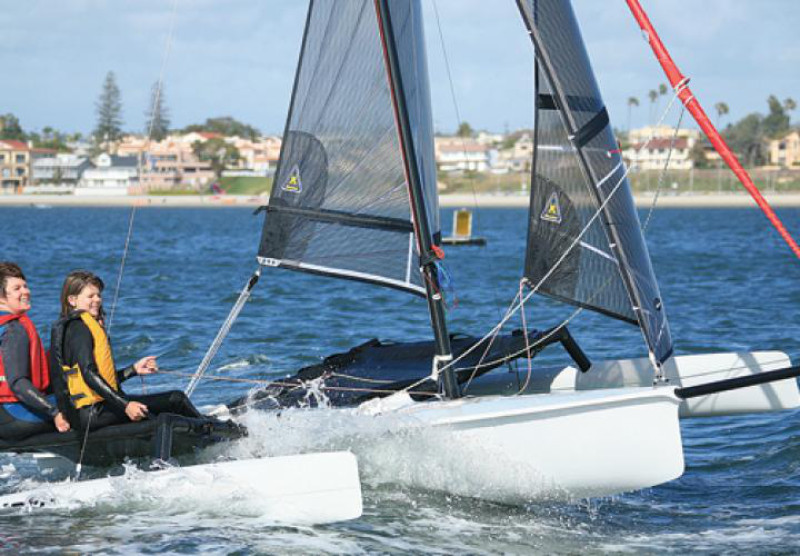
August 01st, 2017
The breeze was mild, but still it made an impression to see Dave Bernsten walk away from the tiller of his 14-foot trimaran, step to the bow, fiddle with an adjustment, then mosey back aft and resume his duties at the helm. The moment speaks to the value proposition of the Weta as stable and forgiving, a viable family playground that will crank out speed thrills when the occasion serves. Wetas started showing up in the USA in noticeable numbers last year—they can be launched from a hoist or a beach—and racing fleets are active now on both coasts.
And that name? Weta is a Maori word for a type of large insect native to the boat’s origins, New Zealand. Apparently the tri’s crossbeam angles reminded somebody of the bug’s legs, and there you go. Every time someone told me how to pronounce Weta, the next person corrected me, so I bounced the question off a Kiwi friend. The answer: as in wetter, the way a Bostonian would say it: Wettah.
Bernsten is the West Coast rep, a former International 14 skipper who, “sails this boat like a dinghy; I act as if the amas aren’t there.” When he’s racing, he means. When his young daughters go along for a ride, the amas matter plenty; little kids wouldn’t be there in an I 14. Class championships sailed to date have emphasized camping, family activities and social time, along the Hobie model, and that’s the vision for the Weta future.
The helm was light and responsive (I think I hear you saying, “Well, duh”), and the boat really steps out with the screecher unrolled. The jib does not roll, but the factory literature urges us to unsnap the jib and set the kids free under mainsail only, which sounds like a good idea to me. This really is the most stable platform I’ve sailed at this size.
Which brings us to, uh, the capsize. Not that we ever came close, or that capsizing is likely. It’s not. But if you’re into speed thrills and sailing in a lot of wind, you could get there. Bernsten says he’s achieved it once. The recovery technique is to flood one ama, right the boat, and then drain said ama asap because you really don’t want to pull a twofer.
My day with the Weta impressed me with clean detailing, such as a mainsheet with a two-part cleating system. If you’re sitting inboard, you’ll use the centerline cleat. When the breeze pipes up and you move outboard, you will use one of the side cleats that are angled to automatically clear the centerline cleat; no conflicts. There’s no head banger (boom, as my nautical friends say), and the standard Gaastra sails will stand up to a racer’s scrutiny.
With any trailerable boat, easy launching makes a huge difference to user satisfaction. I believe the Weta delivers here, too. The standard dolly is designed to nestle the amas and the two-part carbon mast. Those amas are an easy lift, and their carbon arms fit handily into the center hull, lock with fiber loops, and then lock tight when shrouds are fitted and tensioned. It really was an operation of 20 minutes or less getting into the water or out. Dismantled on its dolly, a Weta collapses to about the space of a Laser.
Returning to the value proposition: Wetas went into production in 2006 in China, where it is possible to build the boats in fiberglass with carbon parts at a retail price of $10,995. Just how important is China to meeting that price? When Bernsten wanted to buy decals for the sails of his West Coast boats, he was quoted $14 per decal in the U.S., versus 40 cents per in China. Whoa.
As we reached our little yellow Weta across San Francisco Bay, I looked out to the west and saw a freighter inbound with a stack of containers on deck. I don’t know what was in them, but I think I know why they were inbound.
Specifications
LOA: 14'5"
Beam: 11'6"
Trailer Beam: 5'6"
Weight: Main hull 123 lbs, float beam/frame 37 lbs
Sail area main: Main 89 sq. ft., jib 34 sq. ft., screecher 86 sq. ft.
Construction: Fiberglass/carbon spars
By Kimball Livingston
Source: https://www.sailmagazine.com/boats/weta-trimaran